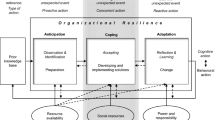Abstract
Since its nascence, computational organization theory has predominantly relied on classical probability theory to model and simulate organizational properties. However, key assumptions of classical probability theory conflict with empirical observations of organizational behaviors and processes, thereby raising the question if an alternate theoretical basis for probabilistic modeling of organizations might improve the relevancy of computational organization research. In the context of the garbage can model of organizational decision-making, this paper provides two examples—order effects and system measurement—to illustrate the inadequacy of classical probability theory and to stimulate discussion on the merits of incorporating quantum probability theory in computational models. This paper recommends that future work explore the sensitivity of computational organization theory models to probability theories, the impacts associated theoretical assumptions might have on modeling and simulating dynamic organizational interdependencies, and the implications to community practices.

Similar content being viewed by others
Notes
The terms occurrences, outcomes, and events are used synonymously in CPT.
According to the distributive axiom, the grou** of operations has no impact on outcomes. As Boole states, “The result of an action of election is independent of the grou** or classification of the subject” (1948, p. 16). In contrast, the commutative axiom specifies the order of operations has no impact on outcomes. The distributive axiom is central to the Law of Total Probability.
The 1928–1932 Hawthorne studies were instrumental in the development of the neo-classical, or Human Relations, school of organization theory approximately ten years later. Thus, the organization sciences community has had access to empirical evidence for nearly 75 years that CPT might not comprehensively describe organizational properties and behaviors.
References
Arrow K (1974) The limits of organizations. W. W. Norton & Company Inc, New York
Boole G (1948) The mathematical analysis of logic: being an essay towards a calculus of deductive reasoning. Philosophical Library Inc, New York
Burton RM, Obel B (1995) The validity of computational models in organization science: from model realism to purpose of the model. Comput Math Organ Theory 1(1):57–71. https://doi.org/10.1007/BF01307828
Busemeyer J, Bruza P (2012) Quantum models of cognition and decision. Cambridge University Press, Cambridge
Campitelli G, Gobet F (2010) Herbert Simon’s decision-making approach: investigation of cognitive processes in experts. Rev Gen Psychol 14(4):354–364. https://doi.org/10.1037/a0021256
Carley K (1999) On generating hypotheses using computer simulations. Syst Eng 2(2):69–77. https://doi.org/10.1002/(SICI)1520-6858(1999)2:2%3C69::AID-SYS3%3E3.0.CO;2-0
Carley K, Gasser L (2000) Computational organization theory. In: Weiss G (ed) Multi-agent systems: a modern approach to distributed artificial intelligence. MIT Press, Cambridge, pp 299–330
Cohen M, March J, Olsen J (1972) A garbage can model of organizational choice. Adm Sci Q 17(1):1–25. https://doi.org/10.2307/2392088
Dirac P (1958) The principles of quantum mechanics, 4th edn. Oxford University Press, London
Frantz T, Carley K, Wallace W (2013) Computational organization theory. In: Gass S, Fu M (eds) Encyclopedia of operational research and management science. Springer, Boston. https://doi.org/10.1007/978-1-4419-1153-7_143
Galbraith JR (1974) Organization design: an information processing view. Interfaces 4(3):28–36
Galbraith JR (1977) Organization design. Addison-Wesley Publishing Co., Menlo Park
Griffiths R (2003) Consistent quantum theory. Cambridge University Press, Cambridge
Jacobs K (2014) Quantum measurement theory and its applications. Cambridge University Press, Cambridge
** Y, Levitt RE (1996) The virtual design team: a computational model of project organizations. Comput Math Organ Theory 2(3):171–196. https://doi.org/10.1007/BF00127273
Koch J, Eisend M, Petermann A (2009) Path dependence in decision-making processes: exploring the impact of complexity under increasing returns. Bus Res 2(1):67–84. https://doi.org/10.1007/BF03343529
Kolmogorov A (1956) Foundations of the theory of probability, 2nd edn. Chelsea Publishing Company, New York
Landsberger H (1958) Hawthorne revisited: management and the worker, its critics, and developments in human relations in industry. Cornell University, Ithaca
Levitt RE, Orr R, Nissen M (2005) Validation of the virtual design team (VDT) computational modeling environment. CRGP Working Paper Series #25. Stanford University, Stanford.
Lord R, Dinh J, Hoffman E (2015) A quantum approach to time and organizational change. Acad Manag Rev 40(2):263–290. https://doi.org/10.5465/amr.2013.0273
March JG (1978) Bounded rationality, ambiguity, and the engineering of choice. Bell J Econ 9(2):587–668. https://doi.org/10.2307/3003600
Mayo E (1945) The social problems of an industrial civilization. Andover Press, Andover
Perrow C (1999) Normal accidents: living with high-risk technologies, Revis. Princeton University Press, Princeton
Pierson P (2000) Increasing returns, path dependence, and the study of politics. The Am Political Rev 94(2):251–267. https://doi.org/10.2307/2586011
Simon H (1996) The sciences of the artificial. MIT Press, Cambridge
Tversky A, Kahneman D (1974) Judgment under uncertainty: heuristics and biases. Science 185(4157):1124–1131. https://doi.org/10.1126/science.185.4157.1124
Tversky A, Kahneman D (1983) Extensional versus intuitive reasoning: the conjunction fallacy in probability judgment. Psychol Rev 90(4):293–315. https://doi.org/10.1037/0033-295X.90.4.293
Tversky A, Shafir E (1992) The disjunction effect in choice under uncertainty. Psychol Sci 3(5):305–309. https://doi.org/10.1111/j.1467-9280.1992.tb00678.x
Von Neumann J (1955) Mathematical foundations of quantum mechanics. Princeton University Press, Princeton
Wegner D, Erber R, Raymond P (1991) Transactive memory in close relationships. J Pers Soc Psychol 61(6):923–929. https://doi.org/10.1037/0022-3514.61.6.923
Wegner D, Giuliano T, Hertel P (1985) Cognitive Interdependence in Close Relationships. In: Ickes W (ed) Compatible and incompatible relationships. Springer-Verlag, Berlin, pp 253–276. https://doi.org/10.1007/978-1-4612-5044-9_12
White L, Pothos E, Busemeyer J (2015) Insights from quantum cognitive models for organizational decision making. J Appl Res Mem Cognit 4:229–238. https://doi.org/10.1016/j.jarmac.2014.11.002
Acknowledgements
This research is funded by America’s Sea Land Air Military Research Initiative at the Naval Postgraduate School and the Naval Undersea Warfare Center Division, Keyport.
Author information
Authors and Affiliations
Corresponding author
Ethics declarations
Conflict of interest
We have no known conflict of interest to discuss.
Additional information
Publisher's Note
Springer Nature remains neutral with regard to jurisdictional claims in published maps and institutional affiliations.
Rights and permissions
About this article
Cite this article
Mortimore, D., Canan, M. & Buettner, R.R. Two probability theories and a garbage can. Comput Math Organ Theory 30, 148–160 (2024). https://doi.org/10.1007/s10588-023-09378-3
Accepted:
Published:
Issue Date:
DOI: https://doi.org/10.1007/s10588-023-09378-3




